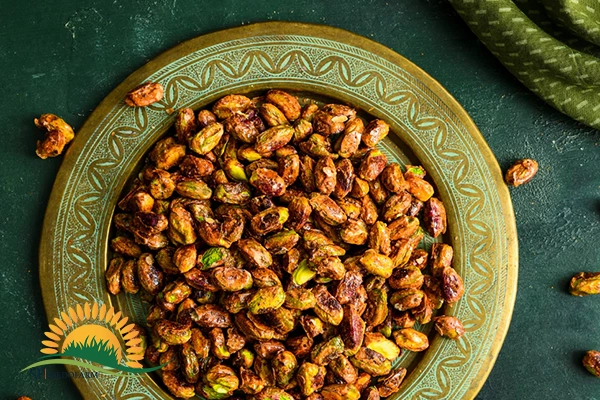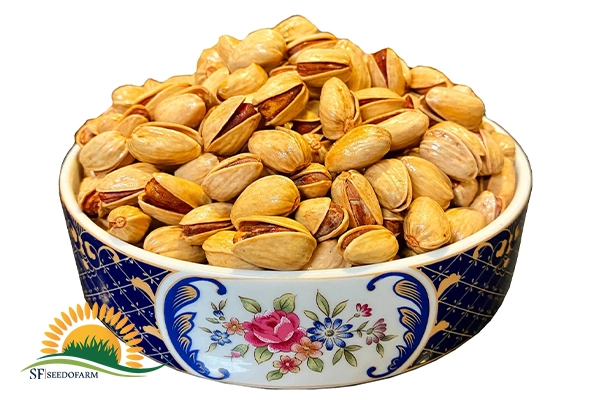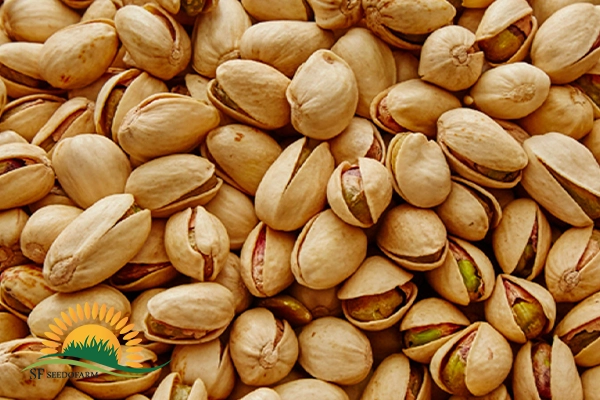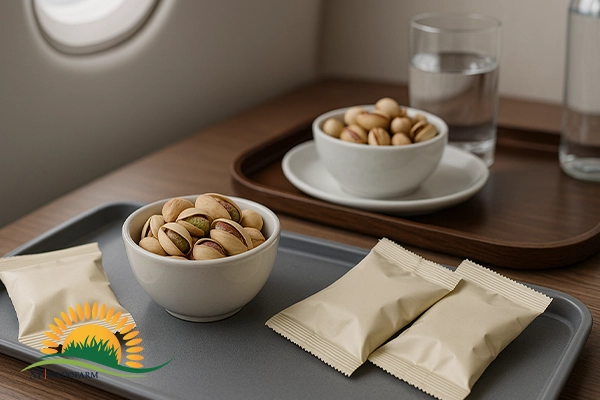Professional pistachio roasting is a controlled balance of heat transfer, airflow, and bed depth applied to nuts pre-conditioned to the right pistachio moisture level (typically ≤5% finished). Using well-defined pistachio roasting profiles—time–temperature curves matched to equipment and variety—prevents rubbery texture, uneven color, and stale flavors. The result is consistent crunch, stable shelf life, and reliable seasoning uptake batch after batch.
Introduction: Why Pistachio Roasting Determines Crunch & Color
Roasting is the step that turns good raw pistachios into premium finished product. It fixes aroma, sets texture, and locks in color. If the process is loose—moisture uneven, airflow restricted, or curves improvised—you get three predictable failures: dull aroma, leathery bite, and blotchy browning.
This guide gives production teams a practical framework for pistachio roasting. You will learn:
- How moisture equalization prevents color bands and rubbery centers.
- How bed depth and airflow shape heat transfer on different machines.
- How to select and run pistachio roasting profiles (nine proven curves) for clean label, flavored SKUs, and high-throughput lines.
- How to verify outcomes with simple shop-floor QA: moisture, split ratio, breakage, and sensory notes.
Keep one principle in mind: you do not roast to a time—you roast to a target internal dryness and color. Time and temperature are levers; moisture and sensory are the goals.

Roasting Basics: Heat Transfer, Bed Depth, Airflow
Heat transfer modes. Pistachios heat via convection (hot air), conduction (contact with drum or belt), and a bit of radiation inside hot chambers. Convection dominates in air or fluid-bed roasters; conduction is stronger in drums.
Bed depth. A shallow moving bed gives uniform exposure but demands higher airflow to prevent scorching. A deeper bed improves throughput but insulates inner layers—slowing dry-down and encouraging uneven color. Start with the manufacturer’s recommendation, then tune in 10–15% increments while tracking color variance (ΔE) and moisture spread (max–min across five samples).
Airflow and exchange. Air must remove steam as moisture leaves the kernel. Insufficient exchange recycles humidity and stalls drying, producing a “sweated” surface and muted crunch. Verify duct pressures and filter cleanliness weekly; clogged filters quietly add 30–60 seconds to curves and blur color.
Temperature setpoints. Most production pistachio roasting lives between 130–165 °C (266–329 °F) chamber readings, with product exit temperatures lower. Drums often show higher setpoints due to conduction; air roasters can achieve the same internal dryness at lower setpoints thanks to vigorous convection.
Carryover heat. Large kernels (e.g., Jumbo) keep heating for 30–90 seconds after discharge. Account for this with an early pull or active cooling; otherwise color drifts darker in the bin.
Instrumentation. Put at least two thermocouples: one for chamber, one for product (probe basket or traversing probe). Record both; chamber-only logs hide lag and overshoot that damage texture.
Pistachio Moisture Level: Targets, Equalization, and Measurement
The single most important predictor of crunch is finished pistachio moisture level. For shelf-stable retail, target ≤5% moisture; many lines land between 3.5–4.8% depending on desired bite and packaging.
Equalization before roasting. Raw pistachios coming from cold storage or variable warehouse zones often have moisture gradients. If you roast directly, the outer layers dry and brown while cores stay damp—your color bands and rubbery centers appear. Fix this with:
- Temper step (pre-warm): Hold raw product 4–8 hours at production room temperature with ambient airflow (not heated) to reduce internal gradients.
- Gentle pre-dry: On continuous lines, a brief pre-dry stage at 80–90 °C can bring the whole bed into a tighter moisture range before the main roast.
Measuring moisture.
- Reference: Oven-dry method (105 °C, 24 h) on representative composite samples—gold standard for calibration.
- Routine: Handheld moisture meters calibrated against your oven method monthly. Always sample from multiple points in the bin (top/middle/depth) to catch stratification.
- On-line: If available, NIR sensors provide continuous estimates, excellent for catching drift.
Post-roast targets. For unflavored SKUs, 3.8–4.5% is a sweet spot (crisp without brittleness). For heavy coatings, allow a hair more exit moisture (4.6–5.0%) if the coating step includes additional drying.
Cooling and condensation. Cool with forced air to <35–40 °C before sealing. Sealing hot nuts traps vapor, raises local pistachio moisture level, and softens texture within hours.
Pistachio Roasting Profiles (9 Curves You Can Copy)
These pistachio roasting profiles are time–temperature templates you’ll adapt to your machine, load, and variety. Always validate with your own moisture and color targets.
- Light Dry Roast (clean label)
- Goal: bright color, clean aroma, minimal surface oil.
- Template: 135–145 °C chamber, 10–14 min (air roaster) or 8–12 min (drum), shallow bed.
- Finish: 4.0–4.5% moisture, immediate forced-air cooling.
- Medium Roast (balanced color)
- Goal: deeper aroma and crunch without dark tips.
- Template: 145–155 °C, 9–12 min (air) or 7–10 min (drum).
- Finish: 3.8–4.3% moisture; ideal for lightly salted SKUs.
- Dark Roast (intense flavor)
- Goal: pronounced toasted notes for premium snackers.
- Template: 155–165 °C, 7–9 min (air) or 6–8 min (drum).
- Notes: tighten bed depth and watch carryover; pull early if tips darken.
- High-Temp Short (HTST)
- Goal: throughput, crisp exterior with limited internal dry-down.
- Template: 165–175 °C, 4–6 min (drum favored).
- Risk: surface scorching if airflow is weak; best for Round where mass is lower.
- Low-Temp Long (LTLT)
- Goal: uniform internal drying for very even crunch.
- Template: 125–135 °C, 16–22 min (air).
- Benefit: narrow moisture spread; great for Akbari to protect shell tips.
- Step Roast (ramp & hold)
- Goal: controlled Maillard development without surface burn.
- Template: 4 min at 135 °C → 5 min at 150 °C → 3–4 min at 158 °C.
- Result: tight color window; good for mixed-nut assortments.
- Two-Stage Roast + Cool
- Goal: manage large kernels (Jumbo) to avoid carryover darkening.
- Template: 6–7 min at 150 °C → partial cool 2–3 min → 3–4 min at 155 °C.
- Result: better control of interior dryness and final hue.
- Roast-then-Season (dry coatings)
- Goal: maximize adhesion of dry spices.
- Template: Medium roast to 4.0% → cool to 35 °C → oil mist + spice tumble.
- Note: do not exceed 0.8–1.2% added oil or you’ll soften the bite.
- Season-then-Roast (wet coatings)
- Goal: glaze, lemon-salt, or syrup-based flavors.
- Template: Light pre-dry to 5.0% → coat → 120–130 °C dry-down to 4.5%.
- Watch: sugar browning point; use lower temps and longer dwell.
Variety fit (quick picks):
- Akbari → LTLT or Step Roast to protect tips and presentation.
- Ahmad Aghaei → Medium Roast; highly forgiving for multi-SKU lines.
- Jumbo → Two-Stage or Medium with proactive cooling.
- Round → HTST or Medium for throughput and even seasoning.

Equipment Notes: Batch vs. Continuous, Drum vs. Air Roaster
Batch drum roasters.
Drums emphasize conduction with supplemental convection. They create a round, toasty profile many buyers love for premium snacks. For pistachio roasting, drum systems excel at darker finishes and HTST runs, but you must watch for hot spots that can over-brown shell tips—especially on Akbari. Keep vanes clean, verify rpm, and log charge weight to control bed behavior.
Continuous air (fluid-bed) roasters.
Air roasters rely on vigorous convection for fast, even heat transfer. They’re ideal when you need tight color windows, repeatable pistachio roasting profiles, and predictable throughput across multiple SKUs. Maintain ducts and filters; rising differential pressure quietly lengthens curves and softens crunch.
Which to choose?
- If your priority is ultra-even color at scale, choose air roasters.
- If you want a deeper toasted note, drums can deliver—but control the pistachio moisture level, and add active cooling to tame carryover heat.
- In both cases, document ambient room temperature and RH; they explain day-to-day differences even when setpoints look identical.
Color & Flavor Control: Time–Temp Maps and Carryover Heat
Create a simple time–temperature map for each curve: charge → turning point → drop. Log both chamber and product probes. The gap between them tells you how fast moisture is escaping and whether the surface is outpacing the core.
Color targeting.
- Light, clean label: lower temperature, longer time (LTLT), shallow bed.
- Balanced color: 145–155 °C with strong airflow and mid bed depth.
- Dark, intense: 155–165 °C with strict attention to carryover—pull a touch early and cool aggressively.
Flavor shaping.
Lower regimes preserve fresh nutty notes; higher regimes emphasize roasted/caramel tones. Link your target flavor to the variety: Akbari rewards gentler curves to protect presentation; Round tolerates hotter profiles without uneven spotting.
Carryover heat.
Large kernels (Jumbo) keep cooking for 30–90 seconds after discharge. Plan an early pull or tunnel cooling; otherwise, your perfect gold turns a shade darker in-bin.
Seasoning Uptake: Oil, Dry, and Wet Coatings—When to Apply
Light oil mist (0.8–1.2%).
Improves adhesion for dry spices without softening the bite. Works well after a Medium roast when the surface is warm and dry.
Dry coatings (salt, powders).
Best results appear when finished pistachio moisture level is ~3.8–4.3%. Warm product, low surface oil, and a gentle tumble produce even coverage.
Wet/glaze coatings (lemon-salt, syrup, lacquer).
Use a light pre-dry to ~5.0%, apply the coating, then dry at 120–130 °C back to ~4.5%. Watch sugar browning thresholds; longer dwell at lower temps keeps color clean.
Rule of thumb.
Roast-then-season for dry blends with visual texture. Season-then-roast for wet systems that need a curing/drying step. Validate the order on a 2–5 kg pilot before scaling.
QA Metrics: Moisture ≤5%, Split Ratio, Breakage, Sensory Panel
Moisture (target ≤ 5%).
Finished pistachio moisture level at or below 5% predicts crunch and shelf life. Verify before and after packaging to catch moisture rebound.
Split ratio (open-mouth %).
High split ratio increases perceived quality. For premium Akbari/Jumbo, set tight limits on closed/empty shells; document them in the PO.
Defects & breakage.
Control shell staining, foreign matter, and broken kernels by combining optical and manual inspection. Define acceptance per 1,000 g and audit against incoming lots.
Sensory panel.
Score color, aroma, crunch, off-flavors with a 3–5 person trained panel. Link panel notes to the exact pistachio roasting profiles in your batch record; it’s your fastest continuous-improvement loop.
Packaging checks.
For nitrogen-flushed retail, monitor residual O₂; lower is better for stability. For vacuum bulk, spot-check seal integrity and carton strength.
Troubleshooting: Uneven Color, Rubbery Bite, Surface Scorching
Problem: Uneven color (banding or blotches).
- Likely causes: moisture gradients in raw stock, excessive bed depth, fouled airflow.
- Fixes: temper raw nuts 4–8 h at room temp; reduce bed by 10–15%; clean filters; switch to a Step Roast profile to ease into browning.
Problem: Rubbery or leathery bite.
- Likely causes: high finished moisture, trapped steam (sealed too hot), overloaded cooling bins.
- Fixes: extend dwell 30–60 s or raise setpoint 3–5 °C; cool to < 35–40 °C before sealing; spread shallower layers during cooling.
Problem: Surface scorching / dark tips.
- Likely causes: hot spots in drums, aggressive HTST with weak airflow, carryover heat.
- Fixes: lower peak temp 5–8 °C and add 30–40 s; verify vane condition; pull earlier and use forced-air cooling.
Problem: Poor seasoning adhesion.
- Likely causes: over-oiling, too cold a surface, wrong order of operations.
- Fixes: cap oil at ~1%; season while warm; swap to season-then-roast for wet systems.

Roasting SOP (Step-by-Step for Production Teams)
- Plan the run. Confirm variety, target pistachio roasting profiles, load size, packaging format, and moisture targets.
- Equalize moisture. Temper raw nuts 4–8 h (or brief pre-dry) to narrow the starting range.
- Pre-checks. Validate thermocouples, airflow/pressure, drum rpm or belt speed, and cleanliness.
- Charge & ramp. Load to the documented bed depth. Follow the chosen curve (e.g., LTLT, Medium, Two-Stage). Log chamber and product temps.
- In-process checks. At mid-point, pull a quick sample for color and aroma; adjust dwell ±30 s if drifting.
- Drop & cool. Discharge slightly early for Jumbo/HTST to offset carryover. Force-cool to < 40 °C.
- Season (if required). Apply the chosen method—oil mist + dry spice, or wet glaze + set dry.
- Moisture & sensory. Verify finished pistachio moisture level (aim ≤ 5%). Panel-taste for crunch and off-notes.
- Pack & seal. Use nitrogen flush or vacuum per SKU. Record residual O₂ where applicable.
- Release. Sign off on batch record: counts, moisture, color grade, defects, sensory, packaging checks.
Conclusion: Picking the Right Profile for Each Variety
Consistent pistachio roasting depends on controlled airflow, documented bed depth, and moisture discipline. Start with even raw stock, choose pistachio roasting profiles that fit the variety (LTLT/Step for Akbari, Medium for Ahmad Aghaei, Two-Stage for Jumbo, HTST/Medium for Round), and finish at the right pistachio moisture level to lock in crunch and color. When you log chamber + product temps, verify moisture, and taste every batch, you turn roasting from guesswork into a repeatable production science.
How to source from Seedo Farm: we don’t sell directly online. Send your inquiry via the Contact page with target variety, counts, packaging format, and monthly volume. We’ll share specs, samples, and a tailored quotation.
FAQ: Curves, Cooling, Storage, Rework, Labeling:
What’s the best starting point for pistachio roasting?
Begin with a Medium profile (145–155 °C, 9–12 min air or 7–10 min drum), then tune dwell by ±30 s based on moisture and color.
What finished pistachio moisture level should I target?
Aim for ≤ 5%. Many premium SKUs sit at 3.8–4.5% for crisp bite without brittleness.
How do I prevent carryover darkening?
Drop a bit early and use forced-air cooling. Jumbo requires stricter cooling than Round.
Dry coat first or wet coat first?
Dry blends: roast-then-season on a warm, dry surface. Wet/glaze: pre-dry, coat, then low-temp set to reach the final moisture.
Can I rework a soft batch?
Yes—brief re-dry at 110–120 °C to pull moisture down, then cool and re-seal. Note that repeated heating can dull aroma; rework once only.



